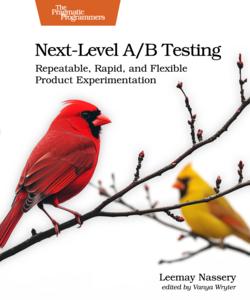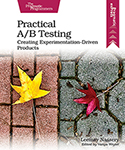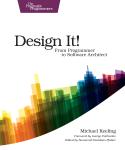About This Title
Pages: 226
Published: June 2025
ISBN: 9798888651308
In Print

Next-Level A/B Testing
Repeatable, Rapid, and Flexible Product Experimentation
by Leemay Nassery
The better the tools you have in your experimentation toolkit, the better off teams will be shipping and evaluating new features on a product. Learn how to create robust A/B testing strategies that evolve with your product and engineering needs. See how to run experiments quickly, efficiently, and at less cost with the overarching goal of improving your product experience and your company’s bottom line.
eBook Formats:
PDF for desktop/tablets
epub for Apple Books, e-readers
mobi for Kindle readers
Get all eBook formats here for $32.95 (USD)
Paperback Formats:
Order via Bookshop (U.S. Only)
Please support indie bookstores!
Find indie bookstores in the U.S. Find indie bookstores around the world.
The long-term success of any product hinges on a company’s ability to experiment quickly and effectively. The more a company evolves and grows, the more demand there is on the experimentation platform. To continue to meet testing demands and empower teams to leverage A/B testing in their product development life cycle, it’s vital to incorporate techniques to improve testing velocity, cost, and quality.
Learn how to create an A/B testing environment for the long term that lets you quickly construct, run, and analyze tests and enables the business to explore and exploit new features in a cost-effective and controlled way. Know when to use techniques—stratified random sampling, interleaving, and metric sensitivity analysis—that let you work faster, more accurately, and more cost-effectively. With practical strategies and hands-on engineering tasks oriented around improving the rate and quality of testing on a product, you can apply what you’ve learned to optimize your experimentation practices.
A/B testing is vital to product development. It’s time to create the tools and environment that let you run these tests easily, affordably, and reliably.
What You Need
N/AResources
Releases:
Contents & Extracts
- Introduction

- Who Should Read This Book
- Simplifying Complex Concepts
- How This Book Is Organized
- Online Resources
- Taking Your Experimentation to the Next Level
- Why Experimentation Rate, Quality, and Cost Matter
- Advancing Your Experimentation Practices
- Increasing Experimentation Rate
- Facilitating an Experimentation Workshop
- Improving Experimentation Quality
- Decreasing Experimentation Cost
- Guiding Principles
- Chapter Roundup: Running an Experimentation Workshop
- Wrapping Up
- Improving Experimentation Throughput
- Reasoning with Limited Testing Availability
- Varying Testing Strategies
excerpt

- Shifting Experimentation Mindset
- Illustrating Interaction Effects
- Defining General Guidelines to Increase Testing Space
- Chapter Roundup: What Type of Testing Strategy Best Suits Your Use Cases?
- Wrapping Up
- Designing Better Experiments
- Improving Experiment Design
- Opting for Sensitive Metrics
- Leveraging the Capping Metric Technique
- Aligning on Experiment
Goal

- Reducing the Number of Variants
- Reducing Up-Front Sample Size with CUPED
- Sharing Experimentation Best Practices
- Chapter Roundup: Identifying Experiment Design Improvements
- Wrapping Up
- Improving Machine Learning Evaluation Practices
- Identifying Challenges with Machine Learning
- Measuring Effect with Offline Methods
- Understanding Why Offline-Online Correlation Is Challenging
- Increasing Reward with Multi-Armed Bandits
- Comparing Multiple Rankers with Interleaving
- Chapter Roundup: When to Implement New Strategies for Machine Learning Evaluations
- Wrapping Up
- Verifying and Monitoring Experiments
- Tracking Metrics to Measure Experimentation Strategy
Effectiveness

- Verifying Experiments Before Launch
- Leveraging Canaries to Catch Issues Early
- Conducting Health Checks with A/A Tests
- Recognizing Spillover Effect
- Structuring the Experimentation Process
- Chapter Roundup: Checklist for Creating an Experimentation Quality Roadmap
- Wrapping Up
- Tracking Metrics to Measure Experimentation Strategy
Effectiveness
- Ensuring Trustworthy Insights
- Why Insights Quality Matters
- Understanding False Positives and False Negatives
- Comparing Effect with Meta-Analysis
- Considering Metric Sensitivity in Relation to Quality Insights
- Increasing Precision with Stratified Random Sampling
- Measuring Outcomes with Covariate Adjustments
- Navigating False Positive Risk
- Doubling Down on Statistical Power
- Preventing False Positives and False Negatives
- Chapter Roundup: Verifying You’re Measuring True Effect
- Wrapping Up
- Practicing Adaptive Testing Strategies
- Navigating the Potential of Adaptive Testing Strategies
- What Is Adaptive Testing?
- Making Decisions Early with Sequential Testing
- Making Multi-Armed Bandits Effective for You
- Opting for Thompson Sampling Algorithm
- Personalizing the Decision with Contextual Bandits
- Generalizing Components to Support Adaptive Testing
- Chapter Roundup: Engineering Team Requirements to Support Adaptive Testing
- Wrapping Up
- Measuring Long-Term Impact
- Why You Should Measure Long-Term Impact
- Defining Relationship Between Short-Term and Long-Term Metrics
- Deploying a Long-Term Holdback
- Leveraging Post-Period Analysis
- Monitoring Impact Continuously After Feature Rollout
- Predicting Long-Term Impact with CLV Models
- Chapter Roundup: Optimizing Your Long-Term Evaluation Strategy Based on Cost
- Wrapping Up
- Tying It All Together
- Sharing a Cautionary Tale
- Building Blocks to Improve Rate, Quality, and Cost
- Understanding the Company’s Strategic Goals
- Keeping Your Users Top of Mind
- Balancing Complexity with Usability
- Considering Your Experimentation Platform’s Robustness
- Comparing Experimentation Cost Versus Quality
- Combating the “Too Costly” Myth
- Increasing Experimentation Rate Is a Balancing Act
- Operating as a Data-Influenced Company
- How to Evaluate a New Strategy
- Revisiting Experimentation at MarketMax
- Chapter Roundup: Tying It All Together
- Wrapping Up
Author
Leemay Nassery is an engineering leader specializing in experimentation and personalization. With a notable track record that includes evolving Spotify’s A/B testing strategy for the Homepage, launching Comcast’s For You page, and establishing data warehousing teams at Etsy, she firmly believes that the key to innovation at any company is the ability to experiment effectively.eBook Formats:
PDF for desktop/tablets
epub for Apple Books, e-readers
mobi for Kindle readers
Get all eBook formats here for $32.95 (USD)
Paperback Formats:
Order via Bookshop (U.S. Only)
Please support indie bookstores!
Find indie bookstores in the U.S. Find indie bookstores around the world.
Related Titles:

About This Title
Pages: 226
Published: June 2025
ISBN: 9798888651308
Edition: 1
In Print





